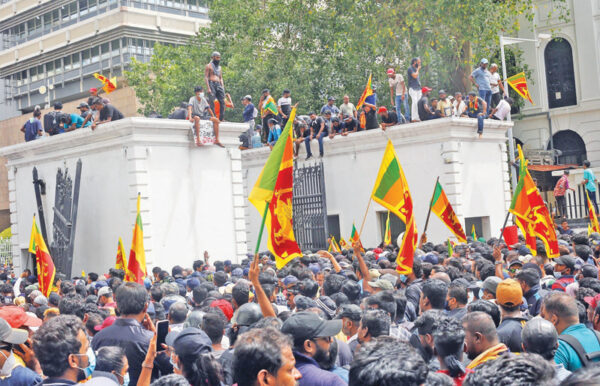Collapse of the Aragalaya

On July 9, it looked as if Sri Lanka was undergoing a “revolution” spearheaded by “peoples’ power” in the raw. Massive crowds had converged on Colombo to force President Gotabaya Rajapaksa to quit. The Presidential Palace, the Presidential Secretariat and the Prime Minister’s office were stormed, vandalized, and occupied. But the most striking act was the burning of Prime Minister Ranil Wickremesinghe’s personal residence, a repository of thousands of books and rare objet d’art.
Sections of the political class, savouring the anti-Government moves with delight, hailed the events as a triumph of the “popular will” over the “corrupt” Establishment. Constitutionalism was devalued. More shockingly, a former Commander of the Sri Lankan Army, a war hero and the country’s only Field Marshal, urged the Security Forces not to obey “illegal” orders.
Under the cover of supporting popular movements as part of their “concern for human rights”, Western envoys kept urging the Government not to use force even to stop vandalism and arson. The fact that scores of houses of ruling party leaders and public transport buses were set aflame, and a Member of Parliament was lynched, was conveniently brushed under the carpet. The Sri Lankan and international media toed a similar line. Even in the face of violence, not seen since the anti-Tamil riots in 1983, Western envoys, the international and local media, kept up the chant that the movement was “peaceful” and that all actions by the law and order machinery were “brutal” and “repressive”.
A fact that both the participants in the Aragalaya and its supporters in the gallery hid from the public view was that a peaceful movement by the educated middle class, that was appalled by the corruption and mismanagement of the Rajapaksa regime, was hijacked by unruly elements led by parties that had no faith in constitutionalism and had had a violent past. Few thought of the consequences of legitimizing violence and unconstitutional actions. It did not dawn on them that once sanctioned, this method of changing Governments would become the norm and that they might themselves become victims of that one day.
The violence of the Aragalaya and the support it seemed to be getting at home and abroad, unnerved President Gotabaya Rajapaksa to such an extent that he abdicated his responsibility to restore law and order and safeguard State institutions. He took the unprecedented step of fleeing the country and resigning from afar.
The Aragalaya then turned to his successor, Ranil Wickremesinghe, who had been duly appointed as per the constitution. The agitators adopted the same kind of tactics to unseat him. An attempt was made to storm and capture Parliament and force the 225 MPs to resign and make way for fresh elections. But the mobs did not realize that the man now in charge was one of grit and determination. He was undaunted by the fact that his residence had been burnt to ashes by the rioters. Unlike his predecessor, he ordered the Security Forces to quell the rioters, without firing a shot, though. Once the chief ordered them officially, the Security Forces did their duty. As the President told them, they saved Parliament and thereby the constitution just as they saved the country from terrorism not so long ago. Thereafter, the ring leaders of violence and those who damaged or stolen Government property were picked up and brought before the courts. This was a clear signal to violence-prone elements in society who thrive during periods of political tension. They went into hiding. Crowds at the protest sites melted, bringing the curtains down on the “revolution.”
The Aragalaya succeeded to the extent that it drove President Gotabaya Rajapaksa out and made the Rajapaksa clan quit the Government wholesale. But it failed to bring Sri Lanka’s political or constitutional system down. It tried to overthrow Gotabaya’s successor, but failed.
The critical factor behind the initial success and the subsequent failure of the Aragalaya was the leadership of the State. President Gotabaya Rajapaksa was overthrown not because of the violence, but because the State law and order machinery had been disabled by a lack of leadership on the President’s part. The top man had lost the will to fight. He failed to give appropriate orders to his Security Forces.
But violence was quelled and the movement collapsed as soon as the leader who succeeded Gotabaya Rajapaksa showed the will to protect law and order and the sanctity of constitutional institutions.
In spite of hostility in Parliament, where the Opposition kept raucously chanting that he had no legitimacy, President Wickremesinghe attended to his executive duties diligently and brought about improvements in the situation regarding essential supplies such as food, fuel and cooking gas.
There were two other reasons why the Aragalaya failed. Firstly, it had no single alternative plan for governance as commentator Victor Ivan put it. All it wanted was the resignation of particular individuals. Secondly, it was disorganised, with no single leader or a single set of leaders. Thirdly, it lacked knowledge of the historical realities. The participants and the leaders did not realize that in Sri Lanka, people have never approved of violence as a means of changing Governments. Every time such an attempt was made, it had been rejected and defeated.
The insurgency of 1971, the Janatha Vimukthi Peramuna’s violent bid to overthrow the Government in 1988-89, had been comprehensively defeated. Parties which had a violent record have been marginalized in elections consistently.
Lastly, the Aragalaya and its supporters forgot that in Sri Lanka, changes in Government have always been brought about through elections. Sri Lanka has a history of elections with universal adult franchise as the basis since 1931, a record no South Asian country can boast of. Democracy runs in the veins of Sri Lankans and that is why the voting percentage has been consistently 80 and above.
Violent change has never been the Sri Lankans’ way, and will never be.







